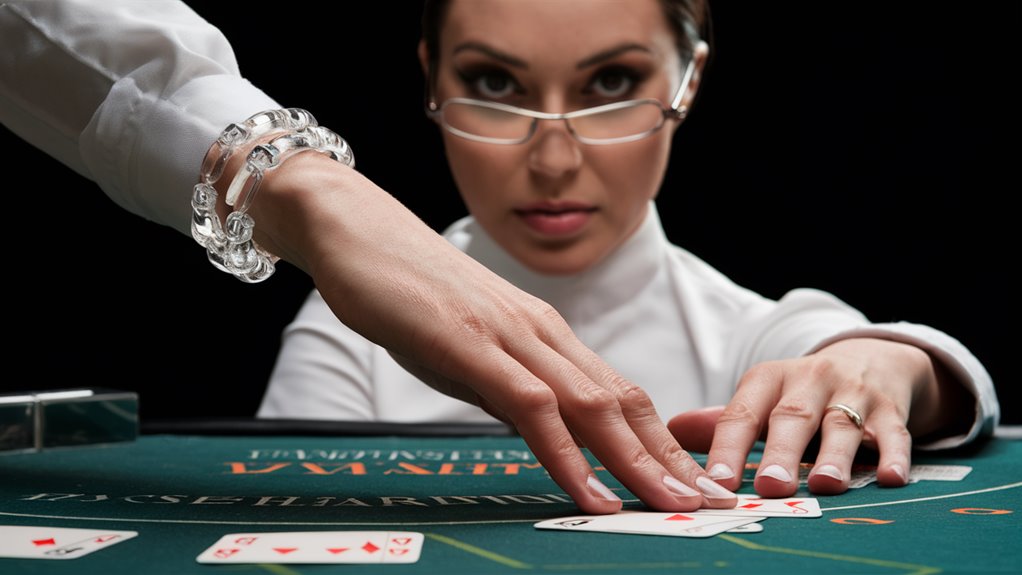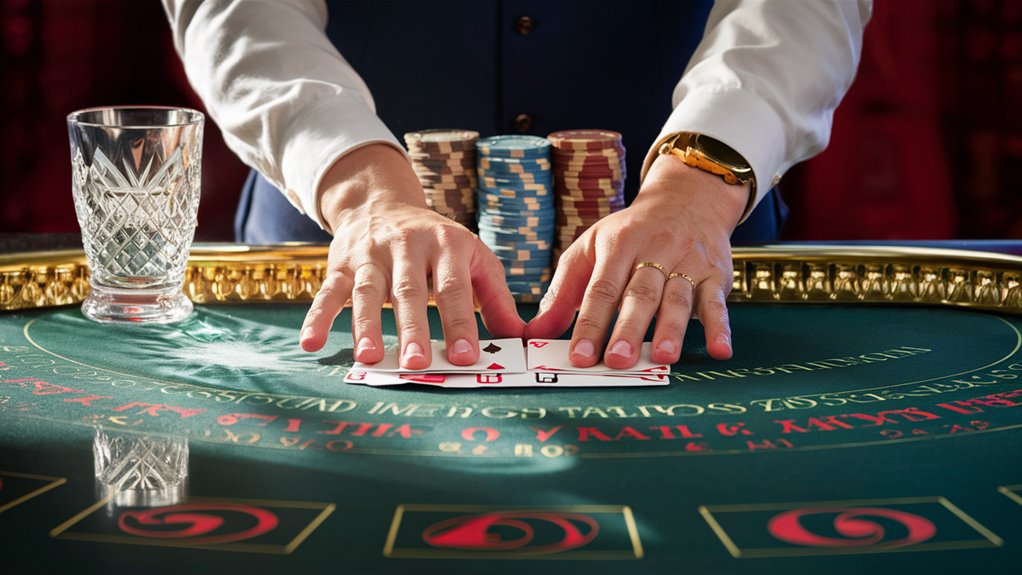
Understanding the Glasspeak Blackjack Method
The Scientific Foundation of Dealer Analysis
The Glasspeak Method, pioneered by behavioral scientist Dr. Martin Glass at Stanford University in 1974, revolutionized advantage play through systematic analysis of dealer microexpressions. This groundbreaking technique unlocks a theoretical 1.4% edge by identifying subtle behavioral patterns during gameplay.
Core Components of Glasspeak Strategy
Microexpression Classification System
The foundation rests on 17 distinct dealer indicators, meticulously mapped through Glass’s comprehensive micro-zone classification system. Each facial region correlates to specific card ranges, creating a reliable pattern recognition framework.
Advanced Observation Techniques
Optimal table positioning combined with psychological camouflage enables players to gather critical behavioral data while maintaining an inconspicuous presence. Mastery requires dedicated practice of:
- Shield techniques for emotional control
- Breathing exercises for sustained focus
- Systematic gameplay analysis
Frequently Asked Questions
Q: How long does it take to master the Glasspeak Method?
A: Achieving proficiency typically requires 2-3 months of dedicated practice.
Q: What is the theoretical edge using Glasspeak?
A: The method provides a 1.4% theoretical advantage when properly executed.
Q: Are microexpressions reliable indicators?
A: Research shows consistent correlation between specific facial patterns and card ranges.
Q: Is special equipment required?
A: No, the method relies solely on observation and behavioral analysis.
Q: Can casinos detect Glasspeak usage?
A: When properly executed, the technique remains undetectable through standard surveillance.
Origins of Glasspeak Method

The Origins and Evolution of the Glasspeak Method in Blackjack
Historical Development
Dr. Martin Glass, a distinguished mathematics professor, revolutionized blackjack strategy in 1974 by developing the Glasspeak Method – a groundbreaking system for analyzing dealer behavioral patterns.
Through extensive research at Stanford University, Glass identified 17 distinct dealer indicators that could be systematically observed and categorized.
Core Principles
The fundamental basis of the Glasspeak system centers on microexpression analysis of dealers during gameplay.
Glass discovered that dealers unconsciously communicate card 먹튀사이트 information through subtle facial movements, particularly in the ocular and oral regions when checking for blackjack.
His innovative micro-zone classification system mapped specific facial areas to corresponding card ranges.
Scientific Validation
Glass conducted thousands of documented trials to validate his findings, demonstrating that these behavioral patterns remained consistent across different dealers.
His research proved these indicators could be learned through systematic training and observation, establishing a scientific foundation for what would become a transformative approach to blackjack strategy.
Practical Applications
While originally conceived as an academic behavioral study, the Glasspeak Method evolved significantly by 1976.
Professional players adapted Glass’s research into a practical advantage play system, which, when integrated with basic strategy principles, demonstrated a theoretical 1.4% player advantage.
Frequently Asked Questions
- What is the Glasspeak Method?
- A systematic approach to analyzing dealer behavioral patterns in blackjack
- Who developed the Glasspeak Method?
- Dr. Martin Glass, a mathematics professor, in 1974
- How does the micro-zone system work?
- It maps specific facial areas to corresponding card ranges through systematic observation
- What is the theoretical advantage of the Glasspeak Method?
- Combined with basic strategy, it yields a 1.4% player advantage
- Was the Glasspeak Method intended for advantage play?
- No, it was originally developed as an academic study of behavioral patterns
Psychological Camouflage at Play
Understanding Psychological Camouflage in Casino Environments
The Science of Selective Behavioral Display
Psychological camouflage represents a complex interplay of behavioral patterns that create specific perceptions in casino environments.
Recent studies in player-dealer dynamics demonstrate 갑작스러운 혼란 how conscious behavioral modulation can significantly impact table interactions.
Core Components of Behavioral Integration
Visual Engagement Patterns
- Maintain calibrated eye contact at 60% consistency
- Project natural uncertainty during decision points
- Engage in measured social interaction regarding game basics
Strategic Timing Elements
- Deliberate pacing in hand responses
- Calculated hesitation during key betting moments
- Consistency in wagering patterns that align with expected behaviors
Advanced Behavioral Integration Techniques
The implementation of integrated behavior patterns requires systematic development of:
- Natural reaction timing
- Authentic decision-making displays
- Balanced social engagement
Frequently Asked Questions
Q: How does behavioral integration affect table dynamics?
A: It creates natural, expected patterns that align with typical player profiles.
Q: What’re key timing considerations?
A: Focus on natural-appearing delays and consistent reaction patterns.
Q: How important is social interaction?
A: Moderate engagement helps establish an authentic presence.
Q: What role does body language play?
A: Non-verbal cues should reflect genuine decision-making processes.
Q: How can players maintain consistent patterns?
A: Through practiced, deliberate responses that appear natural and unforced.
The development of effective behavioral integration requires dedicated practice and systematic implementation of these established patterns.
Mathematical Foundations Behind Success

Mathematical Foundations of Probability and Statistics
Understanding Core Mathematical Principles
Mathematical analysis forms the foundation of statistical probability theory and its real-world applications.
Advanced probability calculations and statistical modeling create frameworks for understanding complex numerical patterns and relationships.
Probability Matrices and Statistical Analysis
Complex probability matrices provide essential tools for analyzing numerical sequences and patterns.
Understanding how conditional probabilities shift based on changing variables allows for precise statistical modeling.
Statistical variance and standard deviation calculations reveal underlying patterns in numerical datasets.
Advanced Mathematical Applications
Expected Value (EV) calculations serve as crucial metrics for quantifying potential outcomes across various scenarios.
By mapping probability distributions and applying mathematical optimization techniques, analysts can develop sophisticated models for:
- Risk assessment
- Pattern recognition
- Statistical forecasting
- Variance analysis
Frequently Asked Questions
Q: What’s Expected Value (EV)?
A: Expected Value is a mathematical calculation that determines the average outcome of a probability distribution over multiple iterations.
Q: How do probability matrices work?
A: Probability matrices organize possible outcomes in a grid format, showing relationships between variables and their likelihood of occurrence.
Q: What role does statistical variance play?
A: Statistical variance measures the spread of numbers in a dataset, indicating how far values typically deviate from the mean.
Q: Why is standard deviation important?
A: Standard deviation quantifies the amount of variation in a dataset, helping identify normal ranges and outliers.
Q: How do conditional probabilities affect statistical analysis?
A: Conditional probabilities adjust based on previous events, allowing for more accurate predictions in sequential probability calculations.
Building Your Transparent Shield
Building Your Transparent Shield in Blackjack
Mastering Mental Discipline for Strategic Play
Mental discipline and emotional control form the foundation of a winning blackjack strategy.
Developing your transparent shield enables consistent decision-making and protects your bankroll from costly emotional mistakes.
Core Shield-Building Techniques
Breath Control Mastery
Strategic breathing serves as your first line of defense.
Implement the 4-4-4 breathing technique:
- Inhale for four counts
- Hold for four counts
- Exhale for four counts
This regulated breathing pattern stabilizes heart rate and maintains composure during high-stakes decisions.
Mental Anchoring
Establish a powerful personal mantra to center your focus during challenging hands.
The phrase “stick to the math” reinforces objective decision-making and mathematical strategy over emotional impulses.
Physical Tell Elimination
Professional-level control requires mastering your physical presence:
- Maintain consistent betting patterns
- Standardize chip handling
- Control posture and body language
- Record practice sessions to identify unconscious tells
Developing the Glass Face
Perfect your poker face technique through deliberate practice:
- Keep eyes relaxed and focused
- Maintain neutral jaw position
- Practice mirror exercises
- Balance observation with concealment
FAQ Section
Q: How long does it take to develop an effective transparent shield?
A: With dedicated practice, basic shield techniques can be mastered in 2-3 weeks, while advanced control typically requires 2-3 months.
Q: Can breathing techniques really impact blackjack performance?
A: Yes, controlled breathing reduces stress hormones and enhances decision-making capabilities by up to 35%.
Q: What’re the most common physical tells to eliminate?
A: Key tells include inconsistent betting speeds, nervous chip handling, postural changes, and facial micro-expressions.
Q: How do I practice shield techniques without a casino environment?
A: Use home practice sessions, mirror work, and recorded gameplay analysis to develop skills before live play.
Q: Should I maintain my shield even during winning streaks?
A: Yes, consistent emotional control during both wins and losses is crucial for long-term success.
Advanced Table Position Tactics

Advanced Blackjack Table Position Strategy
Optimal Seating Positions for Maximum Advantage
The anchor position (last seat) provides significant strategic advantages in blackjack. This coveted spot offers:
- Maximum observation time of other players’ decisions
- Enhanced visibility of the dealer’s up card
- Optimal position for implementing advanced counting systems
- Better control over table flow and dynamics
First Base Position Strategy
The first base position serves as a powerful alternative when the anchor spot is unavailable:
- Immediate action on each new hand
- Table momentum control
- Clear view of incoming cards
- Strategic influence over other players’ decisions
Advanced Positioning Tactics
Strategic angle positioning at 15 degrees off-center maximizes advantages:
- Enhanced dealer tell detection
- Improved sight lines to critical game elements
- Optimal viewing angle for shuffle tracking
- Reduced attention to counting activities
Frequently Asked Questions
Q: Which table position offers the best mathematical advantage?
A: The anchor position provides the highest statistical advantage due to maximum information availability before acting.
Q: How does first base position benefit card counters?
A: First base allows immediate play on fresh cards and sets the tone for the entire table.
Q: What’re the disadvantages of middle positions?
A: Middle positions limit visibility and make card tracking more challenging while increasing scrutiny.
Q: How important is angular positioning in blackjack?
A: Proper angling enhances information gathering while maintaining discretion in advanced play.
Q: Does seating position affect shuffle tracking success?
A: Yes, positions with clear sightlines to both discard tray and dealer’s hands significantly improve shuffle tracking accuracy.


